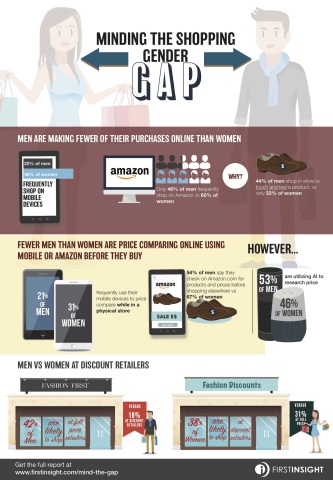LAS VEGAS--(BUSINESS WIRE)--SHOPTALK--Men are not embracing online shopping as much as women and are more likely to shop in-store at full price retailers, according to a new report on retail disruption by First Insight, a technology company transforming how leading retailers make product investment and pricing decisions. Only 22 percent of male respondents reported frequently shopping on mobile devices compared to 40 percent of women, and only 46 percent of men are frequently shopping on Amazon versus 60 percent of women.
The study points to a significant gender gap between how men and women shop and make purchase decisions as the retail industry responds to disruptors such as mobile shopping, Amazon, discount retail and artificial intelligence (AI). Forty-four percent of male respondents cite being able to touch and feel a product as a main driver that takes them in-store, a sentiment shared by only 33 percent of women respondents. Further, according to the survey, men are much more likely to shop at full-priced retailers (42%) over discount retailers (18%), while women are more likely to shop at discount retailers (38%) over full-price (31%).
“The data has unearthed a significant gender gap between how men and women shop and make purchase decisions,” said Greg Petro, CEO and founder of First Insight. “These new disruptive technologies and the growth of discount retailers are making the majority of shoppers more price-sensitive. The fact that men are less inclined to shop online overall and prefer to go in-store is a significant finding, particularly as retailers consider how to align their in-store selection and pricing to meet consumer appetites.”
Results of the survey, which queried 1000 participants in the U.S. on their shopping habits, purchase behavior and influences driving decisions, were announced today during SHOPTALK in Las Vegas.
Download the report and accompanying infographic to see all of the key findings from the study here.
Other significant findings of the survey include:
Men are making fewer purchases online than women
According to the findings, not only are men shopping less frequently than women on Amazon and mobile devices, they are making fewer purchases. Sixty-seven percent of male respondents made two or less purchases on a mobile device in the month prior to the survey, versus 62 percent of women, and 22 percent of women made five or more purchases in the last month versus only 14 percent of men. Further, the majority of women (55%) said their shopping on Amazon has increased in the past year, versus 48 percent of men. Additionally, fewer men subscribe to Amazon Prime (43%) versus women (54%).
Overall, fewer men than women are price comparing online before they buy
Only 21 percent of men frequently use mobile devices to compare prices while in a physical store versus 31 percent of women, and 54 percent of men say they check on Amazon.com for products and prices before shopping elsewhere versus 67 percent of women. However, among respondents who own smart speakers such as Amazon Echo or Google Home, more men (53%) than women (46%) say they have used it to research prices, but women are still driving adoption as 12 percent said they were likely to purchase a smart speaker in the next year versus only six percent of men.
Fewer men than women shop in-store at discount retailers, but online discount shopping is increasing with men
Top discount retailers are seeing a decidedly female in-store clientele. Only 13 percent of men surveyed frequently visit TJ Maxx versus 30 percent of women. Marshalls is slightly more popular with men with 14 percent frequently visiting (versus 26% of women). Only 13 percent of men frequently shop at Home Goods versus 18 percent of female respondents.
However, online discount retailers seem to be gaining traction with men, as 30 percent of male respondents frequently shop at online discount retailers compared to 22 percent at traditional discount retailers. Women, alternatively, show roughly the same increases between online discount and traditional discount retail at 29 percent and 30 percent respectively.
Notes on Survey Methodology and Analysis
First Insight’s findings are based on a targeted sample of 1,000 respondents. The survey was fielded in December of 2017, and was completed through proprietary sample sources amongst panels who participate in online surveys.
About First Insight, Inc.
First Insight is the world’s leading provider of solutions that empower retailers and brands to incorporate the voice of the consumer into the design and merchandising of new products. Through the use of online consumer engagement, the First Insight solution gathers real-time consumer data and applies predictive analytic models to create actionable insights, which drive measurable value. Retailers, manufacturers and brands use the First Insight solution to design, select, price and market the most profitable new products for reduced markdown rates and improved sales, margins and inventory turnover. Customers include some of the world’s leading vertically integrated brands, sporting goods companies, department stores, mass merchant retailers and wholesalers. For further information, please visit www.firstinsight.com.

